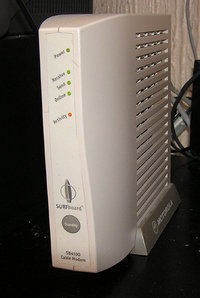Cable modem
|
|
A cable modem is a special type of modem that is designed to modulate a data signal over cable television infrastructure.
The term cable Internet access (or simply cable) refers to the delivery of Internet service over this infrastucture.
Cable modems should not be confused with older LAN systems such as 10base2 or 10base5 that used coaxial cables — and especially not with 10broad36, which actually utilized the same sort of cable as CATV systems.

Cable modems are primarily used to deliver broadband Internet access, taking advantage of unused bandwidth on a cable television network.
Along with digital subscriber line technology, cable modems ushered in the age of broadband Internet access in developed countries. Prior to the availability of such systems, Internet access involved slow dial-up access over a public switched telephone network.
Users in a neighborhood share the available bandwidth provided by a single coaxial cable line. Therefore, connection speed can vary depending on how many people are using the service at the same time.
Often the idea of a shared line is seen as a weak point of cable Internet access. From a technical point of view, all networks, including DSL services, are sharing a fixed amount of bandwidth between a multitude of users — but because cable networks tend to be spread over larger areas than DSL services, more care must be taken to ensure good network performance.
A more significant weakness of cable networks using a shared line is the risk of loss of privacy, especially considering the availability of hacking tools for cable modems. This issue is addressed by encryption and other privacy features specified in the DOCSIS (Data Over Cable Service Interface Specification) standard used by most cable modems.
| Contents |
DOCSIS Specifications
The cable in is a RG-6 tri-shield, with a F connector.
CDLP
CDLP is a proprietary standard made by Motorola. CDLP CPE was capable of both RF (Cable Network) and PSTN return paths. The standard is more or less defunct now with new providers using DOCSIS and existing providers changing. Sample Motorola CDLP Modem (http://broadband.motorola.com/catalog/productdetail.asp?image=large&productID=221)
The Australian ISP BigPond employed this system when it started Cable Modem trials in 1996. For a number of years cable Internet access was only available to Sydney, Melbourne and Brisbane via CDLP. This network ran parallel to the newer DOCSIS system for a number of years, in 2004 the CDLP network was switched off and now is exclusively DOCSIS.
See also
- Cable modem termination system
- Extension cable
- Rouzbeh Yassini, the "father" of the cable modem
- Uncapping
Cable modem manufacturers
External links
- Cable modem (http://electronics.howstuffworks.com/cable-modem.htm/printable)
- DOCSIS standard (http://www.cablemodem.com/)
- Cable Modem vs. DSL Service (http://www.fact-sheets.com/internet-technology/dsl_vs_cable/) Compares the advantages and disadvantages of cable modem and DSL Internet access.
- The Cable Modem Reference Guide (http://www.cable-modems.org/)
- The Swiss Cable Modem webpage (http://www.cablemodem.ch/)de:Kabelmodem
es:cablemódem fr:Modem câble nl:Kabelmodem fi:kaapelimodeemi
